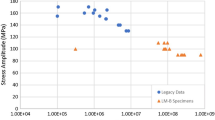Abstract
The role of microstructure and environment in influencing ultra-low fatigue crack propagation rates has been investigated in 7075 aluminum alloy heat-treated to underaged, peak-aged, and overaged conditions and tested over a range of load ratios. Threshold stress intensity range, ΔK0, values were found to decrease monotonically with increasing load ratio for all three heat treatments fatigue tested in 95 pct relative humidity air, with ΔK 0 decreasing at all load ratios with increased extent of aging. Comparison of the near-threshold fatigue behavior obtained in humid air with the data forvacuo, however, showed that the presence of moisture leads to a larger reduction in ΔK0 for the underaged microstructure than the overaged condition, at all load ratios. An examination of the nature of crack morphology and scanning Auger/SIMS analyses of near-threshold fracture surfaces revealed that although the crack path in the underaged structure was highly serrated and nonlinear, crack face oxidation products were much thicker in the overaged condition. The apparent differences in slow fatigue crack growth resistance of the three aging conditions are ascribed to a complex interaction among three mechanisms: the embrittling effect of moisture resulting in conventional corrosion fatigue processes, the role of microstructure and slip mode in inducing crack deflection, and crack closure arising from a combination of environmental and microstructural contributions.
Similar content being viewed by others
References
G.G. Garrett and J.F. Knott:Acta Metall, 1975, vol. 23, p. 841.
B.R. Kirby and C.J. Beevers:Fat. Eng. Mater. Struct., 1979, vol. 1, p. 203.
G. R. Yoder, L. A. Cooley, and T. W. Crooker:Scripta Met., 1982, vol. 16, p. 1021.
J. McKittrick, P.K. Liaw, S.I. Kwun, and M.E. Fine:Metall. Trans. A, 1981, vol. 12A, p. 1535.
A.K. Vasudévan and S. Suresh:Metall. Trans. A, 1982, vol. 13A, p. 2271.
K. J. Nix and H. M. Flowers:Acta Metall., 1982, vol. 30, p. 1549.
J. Petit and A. Zeghloul: inFatigue Thresholds, J. Bäcklund, A. Blom, and C. J. Beevers, eds., EMAS Ltd., Warley, U.K., 1982, p. 563.
E. Hornbogen and K. H. Zum Gahr:Acta Metall., 1976, vol. 24, p. 581.
J. Lindgkeit, A. Gysier, and G. Lütjering:Metall. Trans. A, 1981, vol. 12A, p. 1613.
R. D. Carter, E. W. Lee, C. J. Beevers, and E. A. Starke, Jr.:Metall. Trans. A, 1984, vol. 15A, in press.
M. C. Lafarie-Frenot and C. Gasc:Fat. Eng. Mater. Struct., 1983, in press.
J. A. Feeney, J. C. McMillan, and R. P. Wei:Metall. Trans., 1970, vol. 1, p. 1741.
A.K. Vasudévan and S. Suresh: unpublished results, Alcoa, Pittsburgh, PA, 1983.
A. Hartman:Int. J. Fract. Mech., 1965, vol. 1, p. 167.
F. J. Bradshaw and C. Wheeler:Int. J. Fract. Mech., 1969, vol. 5, p. 255.
R.P. Wei:Eng. Fract. Mech., 1970, vol. 1, p. 633.
R.J. Selines and R.M.N. Pelloux:Metall. Trans., 1972, vol. 3, p. 2525.
F. S. Lin and E. A. Starke, Jr.: inHydrogen in Metals, A.W. Thompson and I. M. Bernstein, eds., TMS-AIME, Warrendale, PA, 1981, p. 485.
S. Suresh, I. G. Palmer, and R. E. Lewis:Fat. Eng. Mater. Struct., 1982, vol. 5, p. 133.
R. A. Schmidt and P. C. Paris: inProgress in Flaw Growth and Fracture Toughness Testing, ASTM STP 536, 1973, p. 79.
R.P. Wei, P.S. Pao, R.G. Hart, T.W. Weir, and G.W. Simmons:Metall. Trans. A, 1980, vol. 11A, p. 151.
L. Christodoulou and H. M. Flower:Acta Metall., 1982, vol. 28, p. 481.
W. Elber: inDamage Tolerance in Aircraft Structures, ASTM STP 486, 1971, p. 280.
S. Suresh, G. F. Zamiski, and R. O. Ritchie:Metall. Trans. A, 1981, vol. 12A, p. 1435.
S. Suresh:Metall. Trans. A, 1983, vol. 14A, p. 2375.
K. Minakawa and A.J. McEvily:Scripta Met., 1981, vol. 15, p. 633.
S. Suresh and R.O. Ritchie:Metall. Trans. A, 1982, vol. 13A, p. 1627.
G. T. Gray, III, A. W. Thompson, and J. C. Williams:Metall. Trans. A, 1983, vol. 14A, p. 421.
M.O. Speidel:Proceedings of NATO Conference, Brussels, 1971, p. 289.
M.O. Speidel: Ohio State University Report, 1975.
F. S. Lin and E.A. Starke, Jr.:Mater. Sci. Eng., 1980, vol. 43, p. 65.
W. W. Gerberich, W. Yu, and K. Esaklul:Metall. Trans. A, 1984, vol. 15A, in press.
D. J. Duquette:Corrosion Fatigue, Proceedings of AGARD Conference #316, Turkey, 1981, in press.
S. Suresh and A. K. Vasudévan: inConcepts of Fatigue Crack Growth Thresholds, proceedings of AIME Symposium, October 1983, Philadelphia, PA, D. L. Davidson and S. Suresh, eds., in press.
Author information
Authors and Affiliations
Rights and permissions
About this article
Cite this article
Suresh, S., Vasudévan, A.K. & Bretz, P.E. Mechanisms of Slow Fatigue Crack Growth in High Strength Aluminum Alloys: Role of Microstructure and Environment. Metall Trans A 15, 369–379 (1984). https://doi.org/10.1007/BF02645122
Received:
Issue Date:
DOI: https://doi.org/10.1007/BF02645122




